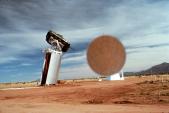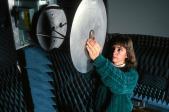GTRI built the world's largest outdoor compact radar range for the U.S. Army in 1989 at Fort Huachuca, Arizona. The facility was designed to measure antenna performance from six to 40 GHz on vehicles and helicopters. It includes a 75-foot parabolic reflector and a lift capable of positioning objects up to 50 feet long and weighing as much as 70 tons.
An antenna's performance varies across different frequencies. It is dependent on its location, as well as the shape of the object upon which it is mounted. In the late 1960s, to determine the best antenna location for a particular situation, Richard C. Johnson invented the compact radar range.
The technique simulates a plane wave over the entire antenna undergoing testing. It involves two main elements: a parabolic reflector and a mechanical device that lifts and rotates the target antenna.
Although the compact range operates in a relatively small space (most are indoors), it can measure the radiation patterns of antennas as they would occur over long distances. Other advantages of indoor compact ranges are security and the ability to operate regardless of weather conditions.
The alternative to a compact range is a far-field range test site, consisting of two towers whose distance apart depended on the target size and frequencies studied. One tower held the antenna under test while the other received the signals. Under many circumstances, given the size of vehicles and the high frequencies involved, far-field towers would have to be stationed several miles apart.
A typical compact radar range provides a useful measurement area approximating a four-foot cylindrical region large enough for a four-foot reflector, although actual useful area varies with frequency band and accuracy required. Antennas up to eight feet can be handled by the compact range, which includes a dedicated air-handling system for temperature stability.
Visit our Electromagnetic Test and Evaluation Facility website


